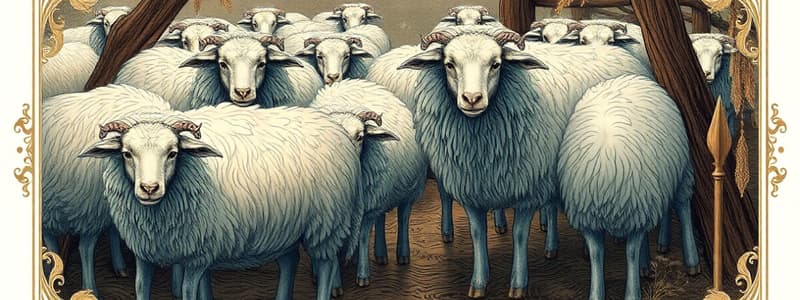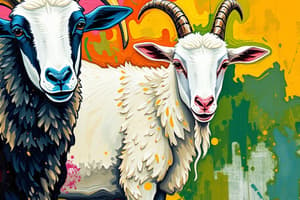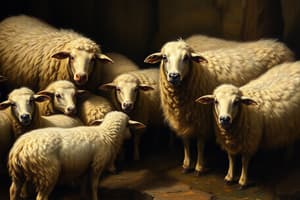Podcast
Questions and Answers
When do most British breeds of sheep typically breed?
When do most British breeds of sheep typically breed?
- Winter
- Summer
- Late Spring
- Late Summer/Early Autumn (correct)
The sheep production cycle includes a lambing period that usually occurs in November.
The sheep production cycle includes a lambing period that usually occurs in November.
False (B)
What is the gestation length for ewes?
What is the gestation length for ewes?
147 days
The euphoric state in sheep is induced by _______ due to hours of darkness.
The euphoric state in sheep is induced by _______ due to hours of darkness.
Match the following terms related to sheep production with their descriptions:
Match the following terms related to sheep production with their descriptions:
What is one key advantage of indoor lambing?
What is one key advantage of indoor lambing?
Outdoor lambing is generally easier to monitor than indoor lambing.
Outdoor lambing is generally easier to monitor than indoor lambing.
What should be considered when grouping ewes before lambing?
What should be considered when grouping ewes before lambing?
Ewes need to be fed ______ times their maintenance requirements by the time of lambing.
Ewes need to be fed ______ times their maintenance requirements by the time of lambing.
What is a critical nutritional factor for ewes in the last few weeks of pregnancy?
What is a critical nutritional factor for ewes in the last few weeks of pregnancy?
Shearing ewes before lambing can help reduce humidity when housed indoors.
Shearing ewes before lambing can help reduce humidity when housed indoors.
What is a potential disease risk associated with outdoor lambing?
What is a potential disease risk associated with outdoor lambing?
Match the lambing method with its feature:
Match the lambing method with its feature:
What is one benefit of housing lowland sheep during lambing?
What is one benefit of housing lowland sheep during lambing?
Hill sheep are usually housed with limited shelter during lambing.
Hill sheep are usually housed with limited shelter during lambing.
What is the purpose of moving ewes prior to lambing to more sheltered grazing areas?
What is the purpose of moving ewes prior to lambing to more sheltered grazing areas?
Housing for lowland sheep needs to be well __________ and have ample dry bedding.
Housing for lowland sheep needs to be well __________ and have ample dry bedding.
Match the type of sheep with their housing needs:
Match the type of sheep with their housing needs:
Which of the following describes the lambing process?
Which of the following describes the lambing process?
Ewe and lambs are typically penned individually for bonding.
Ewe and lambs are typically penned individually for bonding.
Why is it important for housing to be well-ventilated?
Why is it important for housing to be well-ventilated?
Lowland sheep are typically brought into __________ weeks before lambing to acclimatise.
Lowland sheep are typically brought into __________ weeks before lambing to acclimatise.
What is a major risk associated with a lack of proper housing for ewes during lambing?
What is a major risk associated with a lack of proper housing for ewes during lambing?
What occurs in July of the annual sheep cycle?
What occurs in July of the annual sheep cycle?
The gestation length for a ewe is approximately 145 days.
The gestation length for a ewe is approximately 145 days.
What is the recommended feed for ewes during the early phase of pregnancy?
What is the recommended feed for ewes during the early phase of pregnancy?
During days 42 to 90 of pregnancy, ewes need an additional _____ MJ/day.
During days 42 to 90 of pregnancy, ewes need an additional _____ MJ/day.
Match the following months of the sheep cycle with the activities that occur:
Match the following months of the sheep cycle with the activities that occur:
Why is proper feeding important during the early phase of ewe pregnancy?
Why is proper feeding important during the early phase of ewe pregnancy?
Lambs are continuously monitored for wool production during the summer months.
Lambs are continuously monitored for wool production during the summer months.
What happens if a ewe is not fed enough during pregnancy?
What happens if a ewe is not fed enough during pregnancy?
Ewes rest and gain _____ during September.
Ewes rest and gain _____ during September.
What is a key concern for ewes during the later stages of pregnancy?
What is a key concern for ewes during the later stages of pregnancy?
Flashcards
Pregnancy Toxaemia (Twin Lamb Disease)
Pregnancy Toxaemia (Twin Lamb Disease)
A condition that affects pregnant ewes carrying twins, often due to inadequate nutrition and characterized by metabolic disturbances.
Late Pregnancy Period (90 days before lambing)
Late Pregnancy Period (90 days before lambing)
The period starting 90 days before lambing and continuing until parturition. Crucial for fetal growth, colostrum production, and preventing pregnancy toxaemia.
Colostrum
Colostrum
The first milk produced by ewes after lambing. Rich in antibodies and nutrients essential for newborn lambs.
Parturition
Parturition
Signup and view all the flashcards
Indoor Lambing
Indoor Lambing
Signup and view all the flashcards
Outdoor Lambing
Outdoor Lambing
Signup and view all the flashcards
Concentrates
Concentrates
Signup and view all the flashcards
Ultrasound Scanning of Ewes
Ultrasound Scanning of Ewes
Signup and view all the flashcards
Tupping
Tupping
Signup and view all the flashcards
Lambing
Lambing
Signup and view all the flashcards
Flushing
Flushing
Signup and view all the flashcards
Weaning
Weaning
Signup and view all the flashcards
Gestation
Gestation
Signup and view all the flashcards
Hill Sheep Lambing
Hill Sheep Lambing
Signup and view all the flashcards
Lowland Sheep Lambing
Lowland Sheep Lambing
Signup and view all the flashcards
Lambing - Feet First
Lambing - Feet First
Signup and view all the flashcards
Lambing - Rapid Delivery
Lambing - Rapid Delivery
Signup and view all the flashcards
Lambing - Bonding
Lambing - Bonding
Signup and view all the flashcards
Lambing - Teat and Milk Check
Lambing - Teat and Milk Check
Signup and view all the flashcards
Body Condition Scoring
Body Condition Scoring
Signup and view all the flashcards
Sheep Tipping
Sheep Tipping
Signup and view all the flashcards
Shearing
Shearing
Signup and view all the flashcards
Vaccination
Vaccination
Signup and view all the flashcards
Lamb Weaning
Lamb Weaning
Signup and view all the flashcards
Direct Slaughter from Weaning
Direct Slaughter from Weaning
Signup and view all the flashcards
Separate Grazing of Ewes and Lambs
Separate Grazing of Ewes and Lambs
Signup and view all the flashcards
Moving Lambs to Stubble Turnips
Moving Lambs to Stubble Turnips
Signup and view all the flashcards
Ewe Rest and Body Condition Score Improvement
Ewe Rest and Body Condition Score Improvement
Signup and view all the flashcards
Gestation Length in Sheep
Gestation Length in Sheep
Signup and view all the flashcards
Early Pregnancy (Conception to 42 Days)
Early Pregnancy (Conception to 42 Days)
Signup and view all the flashcards
Mid-Pregnancy (Days 42-90)
Mid-Pregnancy (Days 42-90)
Signup and view all the flashcards
Nutritional Requirements of Pregnant Ewes
Nutritional Requirements of Pregnant Ewes
Signup and view all the flashcards
Importance of the Placenta in Sheep Pregnancy
Importance of the Placenta in Sheep Pregnancy
Signup and view all the flashcards
Study Notes
Sheep Husbandry (Part 1)
- Hayley Hickling is a teaching fellow in production animal medicine at the University of Surrey.
- Learning objectives include describing the sheep production cycle, essential management procedures (shearing and vaccination), and recognizing husbandry changes in ewes during pregnancy and lambing.
Typical Production System
- Most British sheep breeds are seasonally polyoestrus, breeding when days shorten (late summer/early autumn).
- Melatonin produced by the brain in darker hours regulates the breeding cycle.
- Lambs reach puberty around 8 months of age (if diet is sufficient).
- Gestation length is approximately 147 days.
LO1: Describe the Sheep Production Cycle
- The ewe cycle involves a period of 'putting to ram', lambing, weaning, and potentially being 'flushed' (fed an enhanced diet before mating) or used for early finishing.
- Another option is for older lambs to be finished on roots through winter before slaughter.
- The timeline of the cycle is October-November (putting to ram), March-April (lambing), May-June (weaning), August-September (ewe 'flushing' or alternative path for early finishing), and potentially January after.
The Sheep Calendar (monthly schedule)
- January: Pregnancy scanning, sale of barren ewes.
- February: Pre-lambing vaccines for ewes.
- March: Lamb vaccines, pre-lambing ewe vaccine administration.
- April: Lambing, often within 6 weeks, and best lambs for slaughter.
- May: Lamb vaccines and worming.
- June: Shearing, lamb vaccines.
- July: Lambs weaned and best lambs for slaughter.
- August: Ewes and lambs grazing separately. Monitoring lamb growth.
- September: Pre/post weaning checks, ewe abortion vaccines, finalizing lambs for slaughter.
- October: Flushing for tupping, and monitoring lamb weights/slaughter readiness.
- November: Tupping (mating) of 25-100 ewes per ram, usually 2 ewe cycles in a year.
- December: Rams are removed, scanning for pregnancy (number/presence of foetuses), barren ewes sold, and last year's lambs weighed and sold.
The Annual Sheep Cycle
- October: Pre-breeding checks (rams and ewes), purchase of replacements, ewe abortion vaccines (4-6 weeks pre-tupping), flushing of ewes before tupping.
- November: Tupping of 25-100 ewes per ram, 5th November for the first lambing.
- Lambs are made in autumn, not spring.
LO3: Recognize that Husbandry Requirements Change for Ewes During Pregnancy and Lambing.
- Conception (0-42 days): Feed ewes for maintenance only (grass/forage).
- Days 42-90 of Pregnancy: Increase feed by 2 MJ/day (grass/forage). Monitor for adequate placenta development. Use ultrasound scanning to check for barren ewes and those carrying multiples.
- Days 90-Parturition: Intensive nutrition is needed, including rapid foetal growth and mammary development. Prevention of metabolic diseases (e.g., twin lamb). Feed should be 2X what you typically feed (including quality hay/silage).
- Six weeks pre-lambing, moving ewes to protected fields/indoors reduces humidity problems. Consider grouping similar feed requirements.
Housing
- Hill sheep: Usually lamb outside, using supplementary feeding in sheltered grazing areas with better grass.
- Lowland sheep: Shelter/housing provided for lambing, including adequate ventilation and dry bedding (weeks before lambing). Ewes and lambs often penned individually/small groups.
Lambing
- Normal Presentation: Diagram illustrates a full-term ewe with a lamb in normal presentation showing internal structures
- Lambing Process: Stages of lambing – feet first, then head.
- Post-lambing: Checking teats and milk supply of ewe.
LO2: Provide Brief Details on Essential Management Procedures Such as Shearing and Vaccination
- Shearing: Removing the entire fleece in one piece (versus crutching which only removes around tail and legs). Done usually in Early Summer, typically every year to prevent overheating and flystrike risk. Contractors are common for shearing, they are usually experienced and can shear very fast. Note welfare concerns related to shearing speed, and that animals require time to recover after shearing.
- Vaccination: Administration of a vaccine stimulates the immune system to develop immunity for a specific pathogen. Used to prevent diseases within/between sheep flocks. Note specific vaccines e.g., Clostridium spp., Pasteurella (Mannheimia haemolytica), enzootic abortion, and toxoplasmosis. Vaccinating is commonly done 4 weeks before lambing, and the process in subcutaneously (under the sheep's skin). Care/welfare considerations are important during injections and the afterward monitoring.
Ageing Sheep
- Estimating age based on mouthing (teeth replacements).
Body Condition Scoring
- Visual and tactile assessment for body condition. The scoring system has five points.
Sheep Tipping
- Correct procedure for safely positioning sheep for handling.
Foot Trimming
- Routine trimming isn't recommended. Importantly, examination of sheep feet should be done routinely to identify lameness issues.
Studying That Suits You
Use AI to generate personalized quizzes and flashcards to suit your learning preferences.




